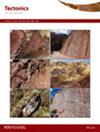菲律宾马斯巴特岛 2020 年 6.6 级马斯巴特地震相关的地表破裂和断层特征
IF 3.6
1区 地球科学
Q1 GEOCHEMISTRY & GEOPHYSICS
引用次数: 0
摘要
2020 年 8 月 18 日,马斯巴特岛发生了 6.6 级地震。这次地震事件是 17 年来第二次发生强震(M > 6),因此有必要进一步调查这次地震事件的特征。在本研究中,我们利用干涉合成孔径雷达、震度分析和实地调查,全面描述了与此次地震相关的共震和震后滑动特征。我们的研究结果表明,尽管发生了震间蠕变,但菲律宾断层马斯巴特段沿岸发生了长达 50 千米的断层断裂,并绘制了长达 23 千米的地表断裂图。滑移分布显示,向西北方向的位移向蠕变段递减,震中附近的左侧位移最大为 0.97 米。向东南离岸方向,断裂终止于断层的左侧台阶。虽然地表断裂看起来相对平直且狭窄集中,但次级断裂和绘制的离岸断层显示马斯巴特岛东南部的横断断层结构更为复杂。这种断层的复杂性代表了一个有利于高应力积累和断裂发生的凸缘。震后滑动沿陆上蠕变段持续数月。根据对马斯巴特断层段累积滑移和共震滑移的全面测量,我们计算出与 2020 年地震类似的地震滑移率为 2.8 至 3.8 厘米/年,重现间隔为 16 至 41 年。我们的研究突显了断层特性(包括几何形状和耦合状态)的异质性如何影响地震的滑移和震级分布。2020 年马斯巴特地震为马斯巴特地区菲律宾断层的破裂动力学和断层行为提供了宝贵的见解。本文章由计算机程序翻译,如有差异,请以英文原文为准。
Surface Rupture and Fault Characteristics Associated With the 2020 Magnitude (MW) 6.6 Masbate Earthquake, Masbate Island, Philippines
On 18 August 2020, Masbate Island was struck by a magnitude (MW) 6.6 earthquake. This seismic event represents the second occurrence of a strong earthquake (M > 6) in 17 years, emphasizing the necessity for further investigation into the characteristics of this event. In this study, we employ Interferometric Synthetic Aperture Radar, seismicity analysis, and field investigations to comprehensively characterize the coseismic and postseismic slip associated with the event. Our findings reveal a 50-km-long fault rupture along the Masbate segment of the Philippine Fault, with ∼23 km surface rupture mapped onshore, despite the occurrence of interseismic creep. The slip distribution demonstrates decreasing displacements northwestward toward the creeping section, with a maximum left-lateral displacement of 0.97 m near the epicenter. Toward the southeast offshore, the rupture terminates at a left stepover of a fault. While the surface rupture appears relatively straight and narrowly concentrated, the secondary ruptures and mapped offshore faults reveal a more complex transtensional fault structure in the southeastern part of Masbate Island. This fault complexity represents an asperity that facilitates high-stress accumulation and rupture initiation. Postseismic slip persists for several months along the onshore creeping segment. Based on comprehensive measurements of both cumulative and coseismic slip along the Masbate fault segment, we calculate a slip rate ranging between 2.8 and 3.8 cm/year and a recurrence interval of 16–41 years for earthquakes similar to the 2020 earthquake. Our study highlights how heterogeneity in fault properties, including geometry and coupling state, influences the distribution of slip and magnitude of earthquakes. The 2020 Masbate earthquake provides valuable insights into the rupture dynamics and fault behavior of the Philippine Fault in the Masbate region.
求助全文
通过发布文献求助,成功后即可免费获取论文全文。
去求助
来源期刊

Tectonics
地学-地球化学与地球物理
CiteScore
7.70
自引率
9.50%
发文量
151
审稿时长
3 months
期刊介绍:
Tectonics (TECT) presents original scientific contributions that describe and explain the evolution, structure, and deformation of Earth¹s lithosphere. Contributions are welcome from any relevant area of research, including field, laboratory, petrological, geochemical, geochronological, geophysical, remote-sensing, and modeling studies. Multidisciplinary studies are particularly encouraged. Tectonics welcomes studies across the range of geologic time.
 求助内容:
求助内容: 应助结果提醒方式:
应助结果提醒方式:


